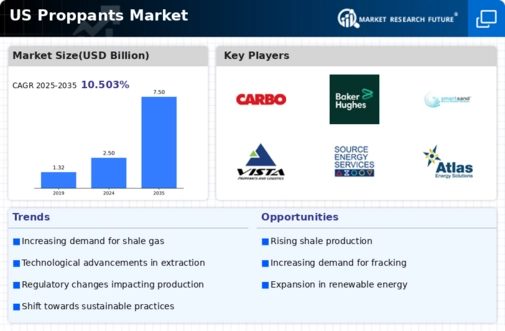The US Proppants Market has evolved significantly in recent years, primarily driven by increasing demand for hydraulic fracturing and the expansion of shale gas exploration. The competitive landscape in this sector is characterized by a mix of established players and emerging companies vying for market share. As exploration and production activities intensify, companies are focusing on product innovation, supply chain efficiency, and strategic partnerships to enhance their competitive edge.Factors such as technological advancements in proppant materials, diverse product offerings, regional distribution networks, and pricing strategies play a crucial role in determining market dynamics.
Understanding the competitive insights provides a clear view of how companies position themselves in this thriving market, which influences both product availability and pricing for end-users in the oil and gas industry.Carbo Ceramics stands out in the US Proppants Market with its strong focus on innovation and sustainability. The company is recognized for its advanced ceramic proppants, which offer superior strength and crush resistance, making them highly sought after in the hydraulic fracturing process.
Carbo Ceramics has developed a robust product line that caters to various customer needs, leveraging its research and development capabilities to create highly engineered proppants that improve well performance.The company’s commitment to quality and technical support has allowed it to establish a reputable presence in the market. Additionally, through strategic partnerships and collaborations, Carbo Ceramics has expanded its distribution network, enhancing its ability to provide effective solutions to operators across various shale plays in the US.
This strong market presence, combined with a focus on sustainable practices, reinforces the company’s competitive position in the proppant sector.Baker Hughes, a key player in the US Proppants Market, offers a comprehensive range of products and services catering to the oil and gas sector. Known for its innovative technology and expert solutions, the company provides various types of proppants including ceramic, resin-coated, and sand proppants, which are tailored to meet the specific needs of its customers.
Baker Hughes has strategically positioned itself within the market through a combination of organic growth and acquisitions, allowing it to enhance its footprint and service capabilities across various regions.The company’s strengths lie in its cutting-edge technology and integrated service offerings, which enable it to deliver comprehensive solutions that optimize production efficiency. Furthermore, Baker Hughes has shown a commitment to sustainability and environmental stewardship, positioning itself well to meet evolving industry standards and customer expectations.
With ongoing investments in technology and a strategic approach to mergers and acquisitions, Baker Hughes is poised to maintain a strong competitive edge in the US Proppants Market.




















